Applications of Photovoltaic PV Power Today
Sunday, November 29, 2020
Solar Panels for Your Home - How to Choose The Best
Posted by Mariya at 4:11 AM 6 comments
Applications of Photovoltaic PV Power Today
Tuesday, August 25, 2020
Solar Morrocan Village - the First Village Powered by the Sun in Africa
Posted by Mariya at 5:54 AM 0 comments
Wednesday, July 29, 2020
Foldable Solar Roof For Parking Lots
Posted by Mariya at 6:13 AM 0 comments
Today, solar energy is used all over the world. There are many improvements in already existing solar technologies. Entirely new technologies and innovative solar devices are emerging. More and more people have solar-powered homes. Back in 1956, the cost of solar used to cost around $300 per watt. Now, in the US, you can get rooftop solar for $1.49/watt from Tesla and a similar price from others.
- Entire Panel CHF 800 ($852)
- Quarter Panel CHF 200 ($213)
Tuesday, February 11, 2020
Solar-Powered Backpack
Posted by Mariya at 5:33 AM 2 comments
Monday, January 13, 2020
How to Harvest Solar Energy on Cloudy Days
Posted by Mariya at 6:11 AM 0 comments
Thursday, October 1, 2009
Power Your Home with Solar Roof Tiles
Posted by Mariya at 8:11 AM 4 comments

Solar roof tiles are made with built-in photovoltaic cells and the color of the solar tiles range from blue to violet to gray and blends well with most colors. Solar roof tiles are connected to each other via MC or other suitable connector type used inphotovoltaics and they work like conventional solar panels. One tile produces about 60 - 180 watts of electricity, and an entire roof could definitely power your entire house. A real hot sunny day could even mean profit for you, excess energy can be sold at a nearby company.
Solar roof tiles are more expensive than solar panels but in terms of the advantages it gives to a local user, it should outweigh the cons. Also, the government offers considerate breaks in taxes for homes that use solar power electricity.
Some of the companies currently producing solar roof tiles are General Electric, PowerLight, Sharp Electronics, and SunPower Corp.
Solé Power Tile, created by SRS Energy, is the industry’s first building-integrated photovoltaic product designed specifically for curved-roof systems and in my next post I'm going to write about it.
Friday, February 6, 2009
World's Leading Photovoltaic Companies
Posted by Mariya at 2:18 PM 2 comments
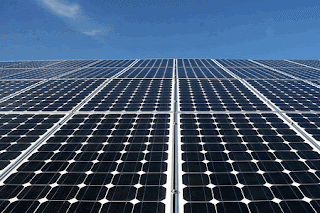
Established in 1999, Q-Cells is the world's second largest cell manufacturer, based in Thalheim, Germany (Q-Cells AG was the single largest producer of solar cells in 2007 according to industry data). Its core business is the development, production and marketing of high-quality (mono- and multi-) crystalline silicon photovoltaic cells.
Based in Wuxi, China, Suntech Power is the world's third largest producer of photovoltaics in 2007. Suntech Power manufactures solar cells and modules and it is a global leader in solar energy as measured by both its production output and the capacity of its solar cells and modules.
Headquartered in Kyoto, Japan, the Kyocera Corporation is a pioneer in the solar energy market and began to develop solar cells in 1975. Today Kyocera is one of the world’s leading manufacturers of solar cells and modules, with a highly controlled mastery of all the production steps from wafer and cell fabrication to module assembly.
The Phoenix, Ariz.-based First Solar is a leader in the development and manufacture of high quality thin film solar modules. They manufacture photovoltaic solar modules developing advanced, thin film semiconductor deposition and high volume manufacturing processes, based on Cadmium Telluride (CdTe).
Motech is the largest manufacturer of photovoltaic cells in Taiwan. For over 25 years, Motech Industries, Inc. (Motech) has been creating high quality products, from testing and measuring instruments to solar cells. Motech has now become one of the top 10 producers of solar cells and the 6th largest crystalline solar cell manufacturer in the world (2007).
SolarWorld is headquartered in Bonn, Germany, and purchased Shell Solar's crystalline silicon activities in 2006. SolarWorld is one of the three largest solar energy groups in the world. The SolarWorld Group of companies is involved in every step of the solar value chain from raw silicon to turn-key solar power systems and is active in growing solar markets around the world.
Japanese company Sanyo Electric has been manufacturing solar cells and panels since 1970s. In 1992, Sanyo Electric started the practical application of installing the first PV generation systems on individual houses in Japan. SANYO HIT (Heterojunction with Intrinsic Thin layer) solar panels are a leader in cell and module efficiency with models up to 16.2 Watts per sq. foot (17.4% module efficiency). On July 29, 2008 the company announced, that it achieved a cell conversion efficiency of 22.3% at the research level.
China-based Yingli Green Energy is one of the world's leading vertically integrated PV product manufacturers. Yingli Green Energy sells PV modules under its own brand name, Yingli Solar, to PV distributors located in various markets around the world, including Germany, Spain, China and the United States.
SunPower Corporation is a Silicon Valley based solar company, and is one of the largest in existence.The company designs and manufactures high-efficiency silicon solar cells and solar panels based on an all-back-contact "All-Black" design. They install them through their subsidiary PowerLight. Their Nellis Solar Power Plant is currently the largest PV installation in North America
Schott Solar Germany is among the world's leading fully integrated manufacturers of PV wafers, cells and modules. The company has more than 40 years of experience and offers reliable PV solar electricity modules for almost any kind of application. Schott Solar is also one of the leading companies in thin film technologies.
Renewable Energy Corporation (REC) is based in Norway, and was established in 1996. Over a relatively short period, REC has become the world's largest producer of poly silicon and wafers for PV applications. The company has seven production plants in three different countries and customers all over the world.
Mitsubishi Electric is one of the world’s largest manufacturers and providers of solar power technology, including PV cells, modules and inverters. The company’s eco-friendly photovoltaic systems are used throughout the world to bring clean, reliable energy to residences, business, power generation plants, schools, and factories.
BP has been involved in solar power since 1973 and its subsidiary, BP Solar, is now a major worldwide manufacturer and installer of PV solar cells, with production facilities in the United States, Spain, India and Australia. Headquarters for BP Solar are located in Frederick - a city in west-central Maryland, United States.
Isofoton is a Spanish company, the biggest solar panel manufacturer in Europe. The company designs and manufactures high-efficiency mono crystalline silicon cells (also the most expensive), and it is currently the largest mono crystalline producer worldwide.
Nanosolar was started in 2002 and is headquartered in Palo Alto, California. Nanosolar is a maker of thin-film solar panels and is a global leader in solar power innovation. Nanosolar Powersheet, a very thin film solar panel has won the Popular Science Innovation of the Year award. The company manufactures Powersheet by printing a solar absorbing “ink” onto a thin rolled metal sheet in a low-cost, fast, continuous process. The company has manufacturing operations in Silicon Valley, California, and the Berlin capital region, Germany.
Tuesday, January 13, 2009
Solar PV Power in Cold Climate
Posted by Mariya at 2:29 PM 9 comments
 Photo credit: altenergy.blog-city.com |
PV solar panels continue to work even in cloudy conditions, although they do produce less electricity. On days with cloud cover or windblown snow, the PV panels' output power is reduced significantly. With sun angles approaching the highest limits and visibility being high, the PV panels reach their rated output power.
|
An example of integrating PV technology in the daily life are solar powered parking meters which are fairly common in Germany and the Netherlands. The electricity which runs them is supplied by small solar panels on top of the parking meters, right there in the streets.
Canada is another cold-weather country where PV technology is quickly gaining ground. PV cells have been used in Canada over the last 20 years or more for many applications. Photovoltaic modules were used as standalone units, mainly as off-grid distributed electricity generation to power remote homes, telecommunications equipment, oil and pipeline monitoring stations and navigational applications. Over the last few years PV technology has also started to be introduced into urban areas, incorporated into the roofs and facades of homes, offices and factories. And the largest solar PV energy park in North America will be located on approximately 300 acres of land in the Township of Stone Mills, Lennox & Addington County, Ontario. The 19-megawatt project, known as First Light, is being built by SkyPower Corp and SunEdison Canada. The construction is anticipated to be completed by the end of 2009 and local communities will benefit from clean renewable energy sufficient to power more than 2,000 homes annually.
Tuesday, December 2, 2008
Basic Things to Consider Before Buying a Solar Electric System
Posted by Mariya at 3:44 PM 2 comments
Solar photovoltaic panels can be installed on the roof, along a wall of the property or as standalone systems. If you are planning to install them on your roof, you need to make sure that the roof is strong enough to hold a solar panel because some of these panels can be quite heavy. A roof inspection (and any necessary repair) is recommended prior to a PV installation. Another thing you need to know is that the more sunlight modules collect, the more electricity they produce, thus the more energy your home will receive. Make sure that the roof (or wherever you intend to install your solar panels) is clear of any obstacles, such as trees or buildings, especially during peak production hours between 10am and 2pm.
Ideally, a solar system will go on a south/southwest-facing roof, although east and west facing roofs are good candidates, as well.
You should decide whether your system will be grid-connected, off-grid or hybrid. With a solar PV system connected to an electric distribution system (grid-connected) you can receive back-up power from it when your system doesn’t produce enough energy for your needs. When your solar PV system produces excess power, that electricity can be send back into the grid, and your local utility is required to buy it from you.
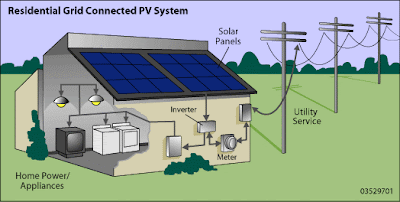
Picture: apps1.eere.energy.gov
A stand-alone (off-grid) solar PV system is independent of an electricity distribution grid operated by a utility. The electricity is provided by solar power alone and stored in a battery for later use. Such systems typically make sense in remote locations.
The average solar PV panel last approximately 30 years and many manufacturer warranties last for up to 20-25 years. Solar PV panels are designed and installed to be low-maintenance. However, it is very important to have your solar panels cleaned regularly because they benefit from being hosed off with water twice a year, especially after long periods without rain. Dust or dirt may cause a 10-15% reduction in their efficiency.
Before buying and installing the panels it is also essential to make sure that you understand the installation regulations in your local area. In most cases it is wise to check with the local authority before installing your solar electric system.
Sunday, November 16, 2008
Solar Energy and Solar Power
Posted by Mariya at 4:58 AM 3 comments
 Solar energy is a more generic term and it describes all the uses of the light and heat from the sun. That includes solar power generation, but also solar thermal for water heating, space heating and cooling, and heat for industrial processes. Solar energy includes also passive solar energy that uses building orientation, design and materials to heat and cool buildings.
Solar energy is a more generic term and it describes all the uses of the light and heat from the sun. That includes solar power generation, but also solar thermal for water heating, space heating and cooling, and heat for industrial processes. Solar energy includes also passive solar energy that uses building orientation, design and materials to heat and cool buildings. Thursday, June 26, 2008
Mandatory solar panels in German town of Marburg
Posted by Mariya at 4:11 PM 1 comments

The solar law was approved by the town's council on June 20, and will take effect Oct. 1. According to the law, a 1 square meter (10 square feet) panel must be installed for every 20 square meters (200 square feet) of surface area. Installing the panels could cost homeowners up to €5,000 ($7,800). The cost would be paid off through savings in energy bills over a 15-year period, the town's mayor, Franz Kahle, said. Those violating the law will face fines starting at €1,000 ($1,500).
The town is home to Marburg University and has about 80,000 residents. Most of the residents support the decision made by the Social Democrats and Greens, but the opposition leaders say that to force people to equip their homes with solar panels equates to a "green dictatorship," and that "nobody dares to say anything."
"Sometimes you must force the hand of consumers for their own good", says the specialist in solar Vajen Klaus, a professor at the University of Kasel.
Sunday, June 22, 2008
Solar Photovoltaic (PV) Panels
Posted by Mariya at 11:06 AM 0 comments
 |
The basic PV or solar cell typically produces only a small amount of power. To produce more power, solar cells can be connected in series to make a PV module (a.k.a. PV panel, solar electric panel). Solar cells or more photovoltaic modules form a PV array. The amount of power solar panels produce is determined by the quality of the solar panel, solar cells and technology used in making the solar panel.
Conventional PV solar panels made from silicon wafers (monocrystalline silicon) convert about 17 to 20 percent of sunlight into usable electricity. The latest solar panels that utilize the new cell can convert into electricity 22 percent of the sunlight they collect. Polycrystalline panels efficiency typically range from 15% to 17%.
Typically, PV panels are mounted on a roof or are integrated in the roof so they act as both a part of the roof or shingles, and a solar panel at the same time. PV can also be incorporated as building facades and canopies. Integrated PV systems are usually installed during construction of the building. The amount of power that a PV panel will deliver is proportional to the amount of sunlight that falls upon it. Ideally PV panels are best placed so that they face south (±450). Photovoltaic panels, however, suffer from decreased power output when they heat up, so high temperatures decrease their efficiency.
When the PV panel is tied to a power grid, the DC (direct current) is converted to alternating current (AC) at grid rating by an inverter. Grid connect PV systems are often integrated into buildings. If you generate more power than you consume, the meter spins backward, as that surplus electricity flows back into the grid for others to use. By returning surplus electricity to the grid, no battery is needed. Some power companies will compensate surplus at a rate that is different than the cost of consumption.
A basic off-grid PV system consists of a solar panel, which generates DC power, a battery bank that stores the DC power, and an inverter (if AC power is required). Modern PV systems are also equipped with some kind of electronic charge controller. The main job of the charge controller is to prevent the battery from being overcharged and also from deep discharging of the battery. The charge controller also protects the solar panels from electrical damage.
The working life of a solar panel is approximately 20 to 25 years and once purchased they continue to produce electrical power for many years. Virtually, they require little or no maintenance, but dust or grime on the front of solar panels will substantially reduce the output, so they should be cleaned periodically.
Labels: green technology, photovoltaics, PV solar panels
Sunday, June 15, 2008
Applications of Photovoltaic PV Power Today
Posted by Mariya at 9:56 AM 0 comments
 |
PV cells have been used for many years in our daily lives to power small applications such as watches and pocket calculators. Today there are available numerous small, medium and large-scale PV applications for residential and industrial purposes. This includes PV power plants, stand-alone PV arrays, building-integrated PV systems, PV solar lighting applications, PV water pumps, solar powered cell phone chargers, and other solar accessories for our homes and businesses. In general, though, PV is not used to generate electricity for space heating, hot water, electric cook stoves or ovens, or other applications with high power needs.
Lighting is one common use for PV systems. Cost-effective applications of lighting powered by photovoltaics include garden lights, lighting for recreational areas, street lights, etc. Remote monitoring, telecommunications equipment, highway construction signs, and navigational warning signals are also excellent applications for PV.
PV systems are an economical option for remote residences and rural areas. In most remote places, it is impossible to connect to the electrical grid and in many such locations, photovoltaic technology is the least-cost option for meeting remote energy needs.
PV systems are used effectively worldwide to pump water for plants, livestock, or humans. Since the need for water is greatest on hot sunny days, PV is a perfect fit for pumping applications. Water can be pumped into a storage tank during daylight hours, then distributed by gravity whenever it is needed. In the developing world, entire village water supplies are powered by photovoltaics.
PV systems offer a number of unique benefits that have led to their rapid growth in popularity in recent years. This growth was particularly impressive in countries such as Japan, Germany and the US.
Tuesday, June 10, 2008
First Solar-Powered Speedboat
Posted by Mariya at 6:30 AM 1 comments
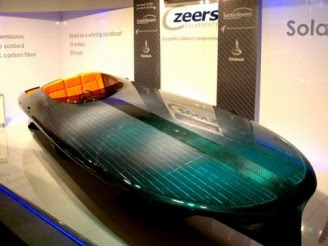 Credit: Czeers |
The speedboat was made from 100% black carbon fiber and covered with 150 square feet (14 square meters) of solar cells. The solar vehicle can approximately reach a top speed of 30 knots (about 35 miles / hour or 55.5 km/ph). The solar powered motor allows the boat to operate quite gentle.
The whole décor is luxurious: the boat has a LCD touch-screen control system and a fine leather interior. The approximate price is seven hundred thousand euro, or about $1.1 million.
Sources: FoxNews & Uberreview
Sunday, June 1, 2008
More Key Steps in Photovoltaic History
Posted by Mariya at 2:38 PM 0 comments
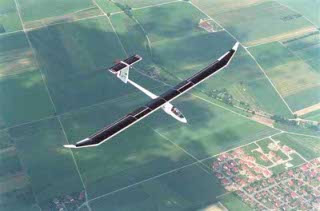 airplane Icare Credit: University of Stuttgart, Germany |
In 1976 NASA’s Lewis Research Center starts the installation of 83 PV power systems on every continent except Australia.
In 1978 was installed the world's first village PV system at Papago Indian Reservation, Schuchuli, Arizona.
In 1980 ARCO Solar is the first company to produce more than 1 MW of PV modules in one year.
In 1981 Paul MacCready builds the first PV-powered aircraft known as the Solar Challenger, which flies from France to England across the English Channel. The aircraft had over 16,000 solar cells mounted on its wings, which produced 3,000 watts of power.
Volkswagen began testing PV arrays mounted on the roofs of vehicles in 1982.
In 1982 a Danish-born Australian eco adventurer Hans Tholstrup drives the first solar-powered car - the Quiet Achiever - almost 2,800 miles between Sydney and Perth in 20 days. The vehicle had photovoltaic system of 1 kW and the average speed was 23 km/h. Tholstrup is the founder of the World Solar Challenge in Australia, considered the world championship of solar car racing.
In 1984, a 1 megawatt photovoltaic electricity plant began to operate in Sacramento, California.
ARCO Solar introduced a G-4000, the first commercial thin film photovoltaic module in 1986.
The world’s most advanced solar-powered airplane, the Icare, flew over Germany in 1996. The wings and tail surfaces of the Icare are covered by 3,000super-efficient solar cells, with a total area of 21 m2.
The 11th tallest skyscraper in New York City, built in the 1990s - the Condé Nast Building, officially 4 Times Square - includes building integrated photovoltaic (BIPV) panels on the 37th through the 43rd floors on the south and west-facing facades to produce a portion of the building’s power.
In 1999 Germany launches a 100,000 solar roofs scheme to promote the on-site generation of clean electricity.
On August 13, 2001 after long research and trial, the solar powered wing aircraft Helios set an unofficial world record by a winged aircraft of flying at a sustained altitude above 96,000 feet (29,250 m) for 40 minutes. Helios is a remotely operated (by two controllers using computers on the ground), solar powered aircraft developed by NASA and AeroVironment Inc.
In 2002 Japan installed 25,000 solar rooftops.
Labels: photovoltaics, solar energy history
Wednesday, May 28, 2008
Bringing PV Cells from Space back down to Earth
Posted by Mariya at 9:00 AM 2 comments
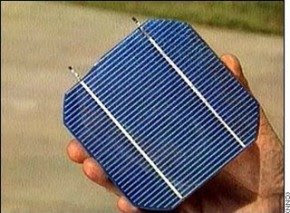 |
In the early 1970's a way to lower to cost of solar cells was discovered. Dr. Elliot Berman, with financial help from Exxon Corporation, designed a significantly less costly solar cell by using a poorer grade of silicon and packaging the cells with cheaper materials. This brought the price down from $100 per watt to around $20 per watt.
The energy crises of the 1970s led to a worldwide push for alternative renewable sources of energy, and photovoltaic were seen as a possible solution. Major research activities in the field took place and the main objective of photovoltaic research has been to reduce costs in order to bring solar power to people.
Significant efforts were made to develop PV power systems for residential and commercial uses, both for stand-alone, remote power as well as for utility-connected applications. The photovoltaic industry attracted the interest of large energy companies and government agencies. With their investment of capital, tremendous improvements in manufacturing, performance and quality of PV modules were possible.
In the 1980s, photovoltaics became a popular power source for consumer electronic devices. PV cells were incorporated in watches, radios, lanterns and other small battery-charging applications. During the same period, international applications for PV systems to power water pumping, refrigeration, telecommunications, rural health clinics, and off-grid households increased dramatically, and remain a major portion of the present world market for PV products.
Labels: photovoltaics, solar energy history
Friday, May 23, 2008
Photovoltaics and the Space Industry
Posted by Mariya at 8:37 AM 0 comments
 |
In 1954 Bell Laboratories built the first photovoltaic module. It was billed as a solar battery and was mostly just a curiosity as it was too expensive to gain widespread use. Bell Labs used a new process called the Czochralski process to develop the first crystalline silicon photovoltaic cell with an efficiency of about 4 percent. The new technology got the first major commercial push when NASA integrated it into its new space program.
In 1955, the preparation on satellite energy supply by solar cells began. Western Electric put for sale commercial licenses for solar cells production. Hoffman Electronics - Semiconductor Division introduced a commercial photovoltaic product with 2 % efficiency for US$ 25 per cell with 14 mW peak power. The energy cost was US$ 1,785 per W.
In 1957, Hoffman Electronics introduced a solar cell with 8 % efficiency. A year later, in 1958, the same company introduced a solar cell with 9 % efficiency. The first radiation proof silicon solar cell was produced for the purposes of space technology. On 17th March 1958, the first satellite powered by solar cells, Vanguard I, was launched. The system ran continuously for 8 years. Two other satellites, Explorer III and Vanguard II, were launched by Americans, and Sputnik III by Russians.
In 1959, Hoffman Electronics introduced commercially available solar cells with 10 % efficiency. Americans launched the satellites Explorer VI with photovoltaic field of 9,600 cells and Explorer VII.
In 1962, Bell solar cells powered Telstar, the world's first communications satellite.
1964 - NASA launches the first Nimbus spacecraft - a satellite powered by a 470-watt photovoltaic array.
In 1965, the Japanese scientific programme for Japanese satellite launch commenced. The following year, in 1966, NASA launches the first Orbiting Astronomical Observatory, powered by a 1-kilowatt photovoltaic array, to provide astronomical data in the ultraviolet and X-ray wavelengths filtered out by the earth’s atmosphere.
Today, the space industry is still a significant user of photovoltaics since they play an important role in space, providing electrical power to satellites in an orbit around the Earth. Solar cells power virtually all satellites, including those used for communications, defence, and scientific research. More than 600,000 flight-proven solar cells are powering over 60 satellites.
The International Space Station uses multiple solar arrays to power all the equipment on board. The success of the space and planetary exploration missions often depends on their on-board PV power sources — providing power for experiments and for getting the data back to Earth. The three Mars rovers - Pathfinder rover Sojourner, Spirit and Opportunity, completed their missions successfully, powered by PV.
Wednesday, May 21, 2008
Photovoltaic History - Key Milestones in the 1900s (Timeline)
Posted by Mariya at 4:34 PM 0 comments
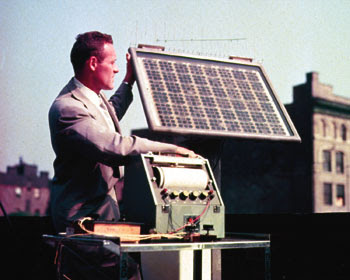 Credit: Bell Labs website |
1954 - Bell Labs announces the invention of the first modern silicon solar cell. The scientists Gerald Pearson, Daryl Chapin, and Calvin Fuller develop the silicon photovoltaic (PV) cell at Bell Labs—the first solar cell capable of converting enough of the sun’s energy into power to run everyday electrical equipment. Bell Telephone Laboratories produced a silicon solar cell with 4% efficiency and later achieved 11% efficiency. Reporting the Bell discovery, The New York Times praised it as "the beginning of a new era, leading eventually to the realization of harnessing the almost limitless energy of the sun for the uses of civilization".
1973 - The University of Delaware builds “Solar One,” one of the world’s first photovoltaic PV) powered residences. The system is a PV/thermal hybrid.
1985 - 20% efficient silicon cell are created by the Centre for Photovoltaic Engineering at the University of New South Wales.
Labels: photovoltaics, solar energy history
Monday, May 19, 2008
Photovoltaic (PV) History - the Beginning
Posted by Mariya at 12:51 PM 0 comments
 |
In 1839 the nineteen-year-old French physicist Alexandre Edmond Becquerel observed the photovoltaic effect for the first time. Experimenting with metal electrodes in a weak electrolyte or conducting solution (such as salt water) exposed to sunlight, he discovered the appearance of small amounts of electric current.
However, Becquerel's discovery couldn't find any practical use and was limited being tagged as an observed phenomenon. The photo conductivity of an element, selenium, was noted by the English electrical engineer Willoughby Smith in 1873 while he was working with Selenium.
In 1876 William Grylls Adams* and his student Richard Day, discovered that illuminating a junction between selenium and platinum can have a photovoltaic effect. This effect is the basis for the modern solar cell. An electricity expert, Werner von Siemens, stated that the discovery was "scientifically of the most far-reaching importance". The selenium cells were not efficient, but it was proved that light, without heat or moving parts, could be converted into electricity.
William G. Adams published also a paper on the selenium cell 'The action of light on selenium,' in "Proceedings of the Royal Society, A25, 113.
In 1883 Charles Fritts, an American inventor, built what many regard as the first true photovoltaic cell. He developed from selenium wafers a solar cell that had less than 1-2% a conversion rate but represents the beginning of solar technology as we know it today.
In 1887 Heinrich Hertz noticed the photoelectric effect, and published his paper entitled “On an Effect of Ultraviolet Light upon the Electric Discharge.” He noticed that the spark created at a receiving electric circuit increased when ultraviolet light hit the negative terminal.
* William Grylls Adams, an English professor of Natural Philosophy at King's College, London was the brother of John Couch Adams, the astronomer who discovered Neptune.
Labels: photovoltaics, solar energy history
Thursday, May 15, 2008
Photovoltaic Cells
Posted by Mariya at 1:58 PM 0 comments
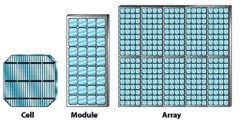 |
The basic building unit of PV technology is the photovoltaic cell (PV cell). PV cells are made of a semiconductor material, typically silicon, which is treated chemically. When light hits the cell, a field of electricity is created within the layers causing the electricity to flow. This "photovoltaic effect" results in direct current (DC) electricity which is the same type of current produced by batteries.
In order to use this energy in most homes, an inverter is used to change the DC electricity to AC. Once electricity is generated, it can go to power anything in your house or be stored in batteries for later use. The greater the intensity of the light, the greater the flow across the layers and so the more electricity generated. But such a system does not necessary require direct sunlight to work.
Single PV cells are connected electrically to form PV modules, which are the building blocks of PV systems. Depending upon the application, the solar modules are typically wired together to form an array. Individual PV cells – averaging about 4 inches per side – typically converts 15% of the available solar radiation into about 1 or 2 watts of electrical power. Larger modules or arrays of modules are used to generate power for the grid.
Labels: photovoltaics, solar energy basics







